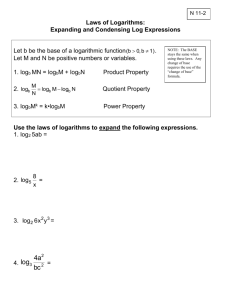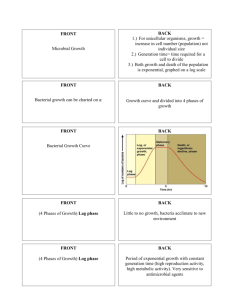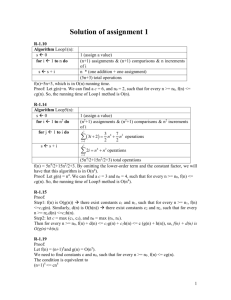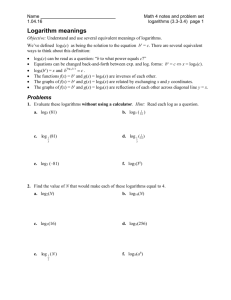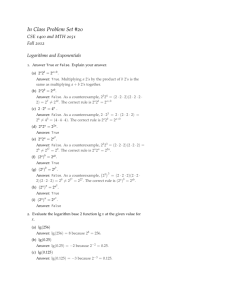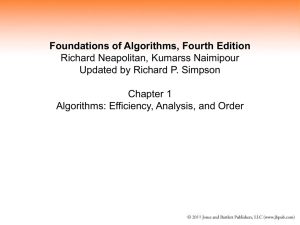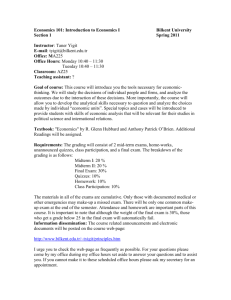n - Bilkent University
advertisement
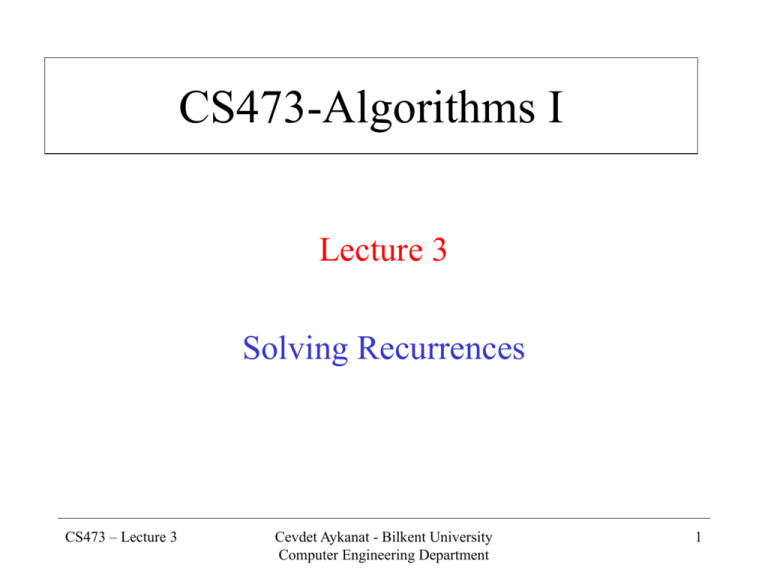
CS473-Algorithms I Lecture 3 Solving Recurrences CS473 – Lecture 3 Cevdet Aykanat - Bilkent University Computer Engineering Department 1 Solving Recurrences • The analysis of merge sort Lecture 1 required us to solve a recurrence. • Recurrences are like solving integrals, differential equations, etc. Learn a few tricks. • Lecture 4 : Applications of recurrences. CS473 – Lecture 3 Cevdet Aykanat - Bilkent University Computer Engineering Department 2 Recurrences • Function expressed recursively if n=1 1 T ( n) T ( n / 2) 1 if n >1 • Solve for n = 2k CS473 – Lecture 3 Cevdet Aykanat - Bilkent University Computer Engineering Department 3 Recurrences • Claimed answer: T(n) = lgn+1 = (lgn) Substitute claimed answer for T in the recurrence Note: resulting equations are true when n = 2k i.e. 1 if n=20=1 lg n 1 k >1 if n=2 (lg( n / 2 ) 1 ) Tedious technicality: haven’t shown T(n) = (lgn) – But, since T(n) is monotonically non-decreasing function of n lg n lg n n2 T (n) T (2 lg( 2 lg n ) ) 1 lg n 1 (lg n) – Thus, ceiling didn’t matter much Cevdet Aykanat - Bilkent University CS473 – Lecture 3 Computer Engineering Department 4 Recurrences • Technically, should be careful about floors and ceilings (as in the book) • But, usually it is okay To ignore floor/ceiling Just solve for exact powers of 2 ( or b) CS473 – Lecture 3 Cevdet Aykanat - Bilkent University Computer Engineering Department 5 Boundary Conditions • Usually assume T(n)= Θ(1) for small n – Does not usually affect soln. (if polynomially bounded) • Example: Initial condition affects soln. – Exponential T(n)=(T(n / 2))2 If T(1)= c for a constant c > 0, then T(2) = (T(1))2=c2, T(4)= (T(2))2=c4, T(n) = Θ(cn) E.g., T (1) 2 T (n) (2 n ) n n However 2 ( 3 ) n T (1) 3 T (n) (3 ) Difference in soln. is more dramatic with T (1) 1 T (n) (1n ) (1) CS473 – Lecture 3 Cevdet Aykanat - Bilkent University Computer Engineering Department 6 Substitution Method • The most general method: 1. Guess the form of the solution. 2. Verify by induction. 3. Solve for constants. • Example: T(n) = 4T(n/2) + n – [Assume that T(1) = Θ(1).] – Guess O(n3) . (Prove O and Ω separately.) – Assume that T(k) ≤ ck3 for k < n . – Prove T(n) ≤ cn3 by induction. CS473 – Lecture 3 Cevdet Aykanat - Bilkent University Computer Engineering Department 7 Example of Substitution T(n) = 4T(n/2) + n 4c (n/2)3 + n = (c/2) n3 + n = cn3 –n ((c/2) n3 - n) desired –residual cn3 whenever (c/2) n3 – n 0, for example, if c 2 and n 1 CS473 – Lecture 3 residual Cevdet Aykanat - Bilkent University Computer Engineering Department 8 Example (Continued) • We must also handle the initial conditions, that is, ground the induction with base cases. • Base: T(n) = Θ(1) for all n < n0, where n0 is a suitable constant. • For 1 ≤ n < n0, we have “Θ(1)” ≤ cn3, if we pick c big enough. This bound is not tight! CS473 – Lecture 3 Cevdet Aykanat - Bilkent University Computer Engineering Department 9 A Tighter Upper Bound? We shall prove that T(n) = O(n2) Assume that T(k) ck2 for k < n: T(n) = 4T(n/2) + n cn2 + n = O(n2) Wrong ! We must prove the I.H. = cn2 - (-n) cn2 for no choice of c > 0. Lose! CS473 – Lecture 3 Cevdet Aykanat - Bilkent University Computer Engineering Department 10 A Tighter Upper Bound! • IDEA: Strengthen the inductive hypothesis. • Subtract a low-order term. Inductive hypothesis: T(k) c1k2 – c2k for k < n T(n) = 4T(n/2) + n 4 (c1 (n/2)2- c2 (n/2)) + n = c1 n2- 2 c2 n + n = c1 n2- c2 n –(c2 n - n) c1 n2- c2 n if c2 > 1 Pick c1 big enough to handle the initial conditions CS473 – Lecture 3 Cevdet Aykanat - Bilkent University Computer Engineering Department 11 Recursion-Tree Method • A recursion tree models the costs (time) of a recursive execution of an algorithm. • The recursion tree method is good for generating guesses for the substitution method. • The recursion-tree method can be unreliable. • The recursion-tree method promotes intuition, however. CS473 – Lecture 3 Cevdet Aykanat - Bilkent University Computer Engineering Department 12 Example of Recursion Tree Solve T(n) = T(n/4) + T(n/2) + n2: CS473 – Lecture 3 Cevdet Aykanat - Bilkent University Computer Engineering Department 13 Example of Recursion Tree Solve T(n) = T(n/4) + T(n/2) + n2: T(n) CS473 – Lecture 3 Cevdet Aykanat - Bilkent University Computer Engineering Department 14 Example of Recursion Tree Solve T(n) = T(n/4) + T(n/2) + n2: n2 T(n/4) CS473 – Lecture 3 T(n/2) Cevdet Aykanat - Bilkent University Computer Engineering Department 15 Example of Recursion Tree Solve T(n) = T(n/4) + T(n/2) + n2: n2 (n/4)2 T(n/16) CS473 – Lecture 3 (n/2)2 T(n/8) T(n/8) Cevdet Aykanat - Bilkent University Computer Engineering Department T(n/4) 16 Example of Recursion Tree Solve T(n) = T(n/4) + T(n/2) + n2: n2 (n/4)2 (n/16)2 (n/8)2 (n/2)2 (n/8)2 (n/4)2 (1) CS473 – Lecture 3 Cevdet Aykanat - Bilkent University Computer Engineering Department 17 Example of Recursion Tree Solve T(n) = T(n/4) + T(n/2) + n2: n2 (n/4)2 (n/16)2 (n/8)2 n2 (n/2)2 (n/8)2 (n/4)2 (1) CS473 – Lecture 3 Cevdet Aykanat - Bilkent University Computer Engineering Department 18 Example of Recursion Tree Solve T(n) = T(n/4) + T(n/2) + n2: n2 (n/4)2 (n/16)2 (n/8)2 5/16 n2 (n/2)2 (n/8)2 n2 (n/4)2 (1) CS473 – Lecture 3 Cevdet Aykanat - Bilkent University Computer Engineering Department 19 Example of Recursion Tree Solve T(n) = T(n/4) + T(n/2) + n2: n2 (n/4)2 (n/16)2 (n/8)2 5/16 n2 (n/2)2 (n/8)2 n2 (n/4)2 25/256 n2 (1) CS473 – Lecture 3 Cevdet Aykanat - Bilkent University Computer Engineering Department 20 Example of Recursion Tree Solve T(n) = T(n/4) + T(n/2) + n2: n2 (n/4)2 (n/16)2 (1) CS473 – Lecture 3 (n/8)2 5/16 n2 (n/2)2 (n/8)2 n2 (n/4)2 25/256 n2 Total = n2 (1 + 5/16 + (5/16)2 + (5/16)2 + ...) = (n2) geometric series Cevdet Aykanat - Bilkent University Computer Engineering Department 21 The Master Method • The master method applies to recurrences of the form T(n) = aT(n/b) + f (n) , where a ≥ 1, b > 1, and f is asymptotically positive. • Three common cases: – Compare f (n) with CS473 – Lecture 3 n logb a Cevdet Aykanat - Bilkent University Computer Engineering Department 22 Three Common Cases • Compare f (n) with 1. f (n) = O( n logb a n logb a : ) for some constant ε > 0. • f (n) grows polynomialy slower than n logb a (by an nε factor). logb a Solution: T(n) = Θ( n ). 2. f (n) = Θ( n logb algkn) for some constant k ≥ 0. • f (n) and n logb a Solution: T(n) = Θ( CS473 – Lecture 3 n grow at similar rates. logb a lgk+1n) . Cevdet Aykanat - Bilkent University Computer Engineering Department 23 Three Common Cases • Compare f (n) with 3. f (n) = ( n logb a n logb a : ) for some constant ε > 0. • f (n) grows polynomially faster than n logb a (by an nε factor). and f (n) satisfies the regularity condition that a f (n/b) c f (n) for some constant c < 1 Solution: T(n) = Θ( f (n) ) . CS473 – Lecture 3 Cevdet Aykanat - Bilkent University Computer Engineering Department 24 Examples • Ex: T(n) = 4T(n/2) + n logb a a=4, b=2 n = n2 ; f (n) = n CASE 1: f (n) =O (n2- ε) for ε=1 T(n) = Θ (n2) • Ex: T(n) = 4T(n/2) + n2 logb a a=4, b=2 n = n2 ; f (n) = n2 CASE 2: f (n) = Θ (n2 lg0n), that is, k=0 T(n) = Θ (n2 lgn) CS473 – Lecture 3 Cevdet Aykanat - Bilkent University Computer Engineering Department 25 Examples • Ex: T(n) = 4T(n/2) + n3 a=4, b=2 n logb a = n2 ; f (n) = n3. CASE 3: f (n) = (n2+ ε) for ε=1 and 4 c (n/2)3 cn3 (reg. cond.) for c=1/2. T(n) = Θ (n3) • Ex: T(n) = 4T(n/2) + n2 / lgn a=4, b=2 n logb a = n2 ; f (n) = n2 / lgn Master method does not apply. In particular, for every constant ε > 0, we have nε = (lgn) CS473 – Lecture 3 Cevdet Aykanat - Bilkent University Computer Engineering Department 26 General Method (Akra-Bazzi) k T (n) aiT (n / bi ) f (n) i 1 Let p be the unique solution to k (a i 1 i /b i) 1 p Then, the answers are the same as for the logb a p master method, but with n instead of n (Akra and Bazzi also prove an even more general result.) CS473 – Lecture 3 Cevdet Aykanat - Bilkent University Computer Engineering Department 27 Idea of Master Theorem Recursion tree: f (n) f (n) a f (n/b) f (n/b) f (n/b) a h= logbn f (n/b2) f (n/b2) f (n/b2) a f (n/b) a2 f (n/b2) #leaves = a h T(1) CS473 – Lecture 3 =a logb n =n logb a Cevdet Aykanat - Bilkent University Computer Engineering Department n logb a T (1) 28 Idea of Master Theorem Recursion tree: f (n) a f (n/b) f (n/b) f (n/b) a h= logbn f (n/b2) f (n/b2) f (n/b2) T(1) CS473 – Lecture 3 f (n) CASE 1 : The weight increases geometrically from the root to the leaves. The leaves hold a constant fraction of the total weight. Cevdet Aykanat - Bilkent University Computer Engineering Department a f (n/b) a2 f (n/b2) n logb a Θ(n T (1) logb a 29 ) Idea of Master Theorem Recursion tree: f (n) a f (n/b) f (n/b) f (n/b) a h= logbn f (n/b2) f (n/b2) f (n/b2) CASE 2 : (k = 0) The weight T(1) CS473 – Lecture 3 f (n) is approximately the same on each of the logbn levels. Cevdet Aykanat - Bilkent University Computer Engineering Department a f (n/b) a2 f (n/b2) n logb a Θ(n T (1) logb a 30 lgn) Idea of Master Theorem Recursion tree: f (n) a f (n/b) f (n/b) f (n/b) a h= logbn f (n/b2) f (n/b2) f (n/b2) T(1) CS473 – Lecture 3 f (n) CASE 3 : The weight decreases geometrically from the root to the leaves. The root holds a constant fraction of the total weight. Cevdet Aykanat - Bilkent University Computer Engineering Department a f (n/b) a2 f (n/b2) n logb a T (1) Θ ( f (n) ) 31 Proof of Master Theorem: Case 1 and Case 2 • Recall from the recursion tree (note h = lgbn=tree height) T (n) (n h 1 logb a ) a f (n / b ) i i i 0 Leaf cost CS473 – Lecture 3 Non-leaf cost = g(n) Cevdet Aykanat - Bilkent University Computer Engineering Department 32 Proof of Case 1 logb a n ( n ) f ( n) for some > 0 logb a n f ( n) (n ) logb a O(n ) f (n) O(n logb a ) f ( n) n g ( n) a O(n / b ) h 1 i i logb a i 0 h1 i i logb a O a (n / b ) i 0 log a i log a i i b b O n a b /b i 0 h 1 CS473 – Lecture 3 Cevdet Aykanat - Bilkent University Computer Engineering Department 33 Case 1 (cont’) h 1 i i h 1 i i h 1 ab ( b ) b i i i a a ( b ) i logb a logb a i i a (b ) i 0 b i 0 i 0 = An increasing geometric series since b > 1 h h logb n b 1 (b ) 1 (b ) 1 n 1 O( n ) b 1 b 1 b 1 b 1 CS473 – Lecture 3 Cevdet Aykanat - Bilkent University Computer Engineering Department 34 Case 1 (cont’) logb a n logb a g ( n) O n O(n ) O O(n ) n O( n T (n) (n logb a logb a (n ) ) g (n) (n logb a logb a ) O(n logb a ) Q.E.D. CS473 – Lecture 3 Cevdet Aykanat - Bilkent University Computer Engineering Department 35 ) Proof of Case 2 (limited to k=0) f ( n) n logb a logb a 0 i (lg n) (1) f (n) (n ) f (n / b ) ( i ) logb a n b h 1 g ( n) a ( n / b ) i i logb a i 0 h1 i n logb a logb a h1 i 1 logb a h1 i 1 a i logb a n a logb a i n a i a (b ) i 0 i 0 i 0 b logb a logb n1 logb a logb a n 1 n log n n lg n b i 0 T (n) n logb a n CS473 – Lecture 3 (n logb a lg n logb a lg n) Cevdet Aykanat - Bilkent University Computer Engineering Department Q.E.D. 36 Conclusion • Next time: applying the master method. CS473 – Lecture 3 Cevdet Aykanat - Bilkent University Computer Engineering Department 37
